


xxxxxWith the resumption of the
war between Britain and France in 1803, Napoleon assembled a
sizeable army at Boulogne. As a consequence, in 1805 Admiral Horatio Nelson was sent to the Mediterranean to blockade the port of
Toulon, where a large French fleet was preparing to assist in an
invasion of England. The French fleet managed to evade the blockade,
and join a Spanish fleet at Cadiz, but when the combined force took
to the high seas in October, the British caught up with it off Cape
Trafalgar on the south-
THE NAPOLEONIC WARS 1803 -
THE BATTLE OF TRAFALGAR -
Acknowledgements
Trafalgar: sketch by the English
painter Clarkson Frederick Stanfield (1793-
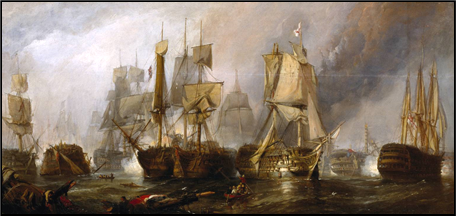 xxxxxThe Battle of Trafalgar, one of the most famous naval
engagements in history, took place off the cape of that name in
south-
xxxxxThe Battle of Trafalgar, one of the most famous naval
engagements in history, took place off the cape of that name in
south-
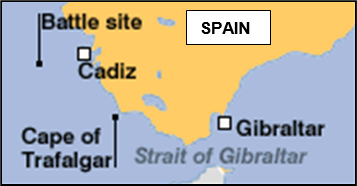 xxxxxNelson, following his successful command at the Battle
of Copenhagen in 1801 (G3b),
returned to England, where the Treaty of Amiens of 1802 had brought
a short period of troubled peace. But he was not long out of action.
When the war broke out again in May 1803, Napoleon assembled a
sizeable army at Boulogne, and Nelson was sent to blockade the
Mediterranean port of Toulon, where a large French fleet was
preparing to assist in the invasion of England. Inx1805,
however, under cover of bad weather, the French fleet, commanded by
Admiral Pierre de Villeneuve,
escaped from Toulon and made for the West Indies. Nelson gave chase,
but Villeneuve evaded him and, turning back to Europe, sailed to
Cadiz. where he was joined by a Spanish fleet. Again the British
attempted a blockade, but this time, under direct orders from
Napoleon to break out and land troops at Naples (to assist the
French campaign there), Villeneuve slipped his combined force out of
Cadiz on the 20th October, hoping to make it safely to the
Mediterranean. On the following day, however, Nelson confronted him
off Cape Trafalgar and battle was joined.
xxxxxNelson, following his successful command at the Battle
of Copenhagen in 1801 (G3b),
returned to England, where the Treaty of Amiens of 1802 had brought
a short period of troubled peace. But he was not long out of action.
When the war broke out again in May 1803, Napoleon assembled a
sizeable army at Boulogne, and Nelson was sent to blockade the
Mediterranean port of Toulon, where a large French fleet was
preparing to assist in the invasion of England. Inx1805,
however, under cover of bad weather, the French fleet, commanded by
Admiral Pierre de Villeneuve,
escaped from Toulon and made for the West Indies. Nelson gave chase,
but Villeneuve evaded him and, turning back to Europe, sailed to
Cadiz. where he was joined by a Spanish fleet. Again the British
attempted a blockade, but this time, under direct orders from
Napoleon to break out and land troops at Naples (to assist the
French campaign there), Villeneuve slipped his combined force out of
Cadiz on the 20th October, hoping to make it safely to the
Mediterranean. On the following day, however, Nelson confronted him
off Cape Trafalgar and battle was joined.
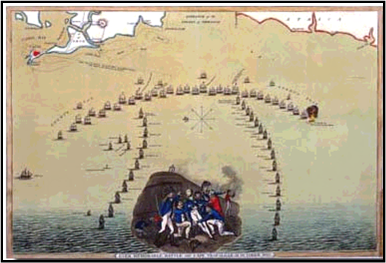 xxxxxThe Franco-
xxxxxThe Franco-
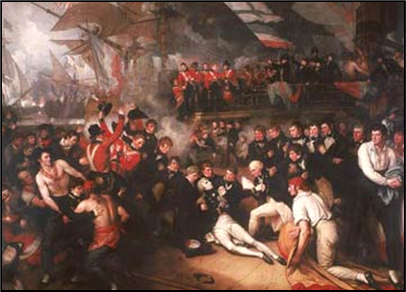
xxxxxThe engagement began about noon and was virtually all over in four hours. By that time the French and Spanish had lost 15 ships sunk, and of the 18 which escaped, two were lost at sea and four were captured early in November. By contrast, the British lost no ships, and their casualties, killed and wounded amounted to about 1,500 compared with some 6,000. In addition, Admiral Villeneuve was captured, along with thousands of his men.
xxxxxA great deal has been
written about Nelson, his naval career and his personal life. Much
of it has been hero worship, some of it has been critical. From the
historical point of view, at least two points are worthy of mention.
Firstly, his tactics as a naval commander, generally unorthodox and
sometimes bordering on the foolhardy, won vital victories for his
nation, and served to determine the course of its history. Secondly,
despite the harsh and cruel aspects of naval life at this time, he
instilled a sense of duty and a spirit of comradeship in all those
under his command. He regarded his ship’s company, and, indeed, his
whole fleet, as a “band of brothers”, united in the service of its
country. This so-
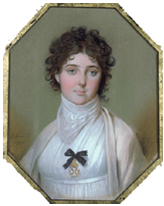
xxxxxIncidentally, Nelson’s body was returned to England, preserved in a barrel of brandy, and a nation in mourning gave its greatest naval commander and tactician a state funeral in St. Paul’s Cathedral. His flagship, The Victory, is preserved at Portsmouth docks in southern England. ……
xxxxx…… The portrait here of his mistress Emma Hamilton was Nelson’s favourite picture of her. He took “My Guardian Angel” with him on all his voyages, and asked for it when he lay dying. ……
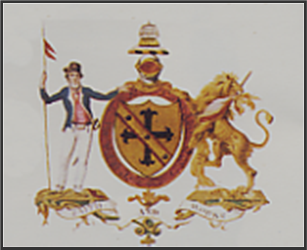 xxxxx…… A monument to Lord Nelson,
“Nelson’s Column”, was completed in Trafalgar Square, London, in
1843. It is 170ft high and surmounted by a 18ft statue of the naval
commander, the work of the sculptor Edward
Hodges Baily (1788-
xxxxx…… A monument to Lord Nelson,
“Nelson’s Column”, was completed in Trafalgar Square, London, in
1843. It is 170ft high and surmounted by a 18ft statue of the naval
commander, the work of the sculptor Edward
Hodges Baily (1788-
xxxxx…… One version of Nelson’s coat of arms shows a British sailor trampling on the Spanish flag (on the left) and the British lion tearing it apart (on the right). ……
xxxxx…… The
bullet that killed Nelson is on display in Windsor Castle, and his
uniform -
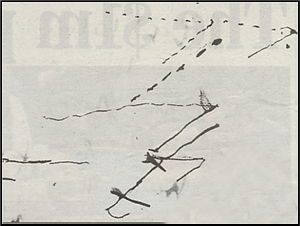
xxxxx……
In May 2002 Colin White, an historian working for the National
Maritime Museum at Greenwich, came across a battle plan while
looking through the museum’s archives. After careful inspection, it
is now believed that these scrawled pen lines on a scrap of
yellowing paper (illustrated)
were made by Nelson himself, just before the Battle of Trafalgar.
Certainly the lower part of the diagram shows two divisions of the
British fleet advancing from the left and cutting through the
enemy’s line at right angles. If the plan was drawn up by Nelson -
Including:
Horatio Nelson
and John Flaxman

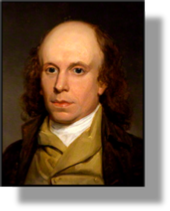 xxxxxNelson’s funeral monument in St. Paul’s Cathedral (illustrated below) was the work
of the English sculptor John Flaxman (1755-
xxxxxNelson’s funeral monument in St. Paul’s Cathedral (illustrated below) was the work
of the English sculptor John Flaxman (1755-
xxxxxFlaxman was born in York, and in 1770 began studying at the Royal Academy Schools in London, where he showed marked promise. As we have seen, early in his career he worked with Josiah Wedgwood (1760 G3a), and many of the fine antique designs which made Wedgwood pottery so famous were of his making. He it was who provided the vast variety of delicate relief figures and medallions, the majority of them based on Greek or Roman models.
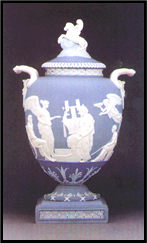
xxxxxHe started working for Wedgwood in 1755, and in 1787 was appointed director of the company’s studio in Rome. He held this office until 1794 and, during this time made a close study of classical art, the works of the Italian sculptor Antonio Canova, and the writings of the German art historian Johann Winckelmann. To this period belongs the publication of his exquisite line drawings for the Iliad and Odyssey, Homer’s ancient epics, and several marble statues, including The Fury of Athamas from Ovid’s Metamorphoses.
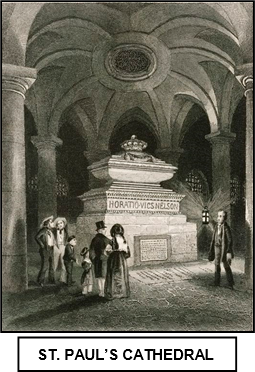 xxxxxOn his return to London in 1794 he continued his book
illustrations, providing drawings for works by the ancient Greek
dramatist Aeschylus, and for Dante’s Divine
Comedy, but he also began to specialise as a monumental
sculptor. His monument to the Earl of Mansfield in Westminster
Abbey, completed in 1801, secured his reputation in this field. He
became a full member of the Royal Academy in
xxxxxOn his return to London in 1794 he continued his book
illustrations, providing drawings for works by the ancient Greek
dramatist Aeschylus, and for Dante’s Divine
Comedy, but he also began to specialise as a monumental
sculptor. His monument to the Earl of Mansfield in Westminster
Abbey, completed in 1801, secured his reputation in this field. He
became a full member of the Royal Academy in 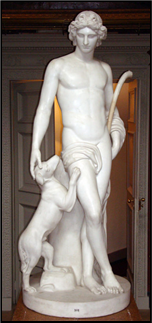 1800,
and was appointed its first professor of sculpture ten years later.
During this period he received and fulfilled a large number of
commissions. In addition to the Nelson monument and those for Joshua
Reynolds and Robert Burns, for example, he sculpted monuments for
Captain James Montague in Westminster Abbey and the figure of
Apollo in Petworth House, Sussex (illustrated
here).
1800,
and was appointed its first professor of sculpture ten years later.
During this period he received and fulfilled a large number of
commissions. In addition to the Nelson monument and those for Joshua
Reynolds and Robert Burns, for example, he sculpted monuments for
Captain James Montague in Westminster Abbey and the figure of
Apollo in Petworth House, Sussex (illustrated
here).
xxxxxA life-
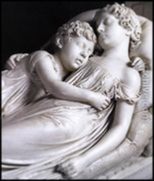 xxxxxIncidentally,
another English sculptor at this time who deserves a mention is Francis Chantrey (1781-
xxxxxIncidentally,
another English sculptor at this time who deserves a mention is Francis Chantrey (1781-
xxxxxNelson’s
funeral monument in St. Paul’s Cathedral was the work of the English
sculptor John Flaxman
(1755-
G3c-


